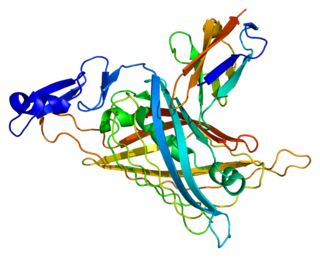
Heparin, also known as unfractionated heparin (UFH), is a medication and naturally occurring glycosaminoglycan. As a medication it is used as an anticoagulant. Specifically it is also used in the treatment of heart attacks and unstable angina. It is given by injection into a vein or under the skin. Other uses include inside test tubes and kidney dialysis machines.

Glycosaminoglycans (GAGs) or mucopolysaccharides are long linear (unbranched) polysaccharides consisting of repeating disaccharide units. The repeating unit consists of an amino sugar along with a uronic sugar or galactose. Glycosaminoglycans are highly polar and attract water; they are therefore useful to the body as a lubricant or as a shock absorber.

Perlecan (PLC) also known as basement membrane-specific heparan sulfate proteoglycan core protein (HSPG) or heparan sulfate proteoglycan 2 (HSPG2), is a protein that in humans is encoded by the HSPG2 gene.
N-acetylgalactosamine-4-sulfatase is an enzyme with systematic name N-acetyl-D-galactosamine-4-sulfate 4-sulfohydrolase. This enzyme catalyses the following chemical reaction

Sulfotransferases EC 2.8.2.- are transferase enzymes that catalyze the transfer of a sulfo group from a donor molecule to an acceptor alcohol or amine. The most common sulfo group donor is 3'-phosphoadenosine-5'-phosphosulfate (PAPS). In the case of alcohol as acceptor, the product is a sulfate (R-OSO3−), whereas an amine leads to a sulfamate (R-NH-SO3−). Both reactive groups for a sulfonation via sulfotransferases may be part of a protein, lipid, carbohydrate or steroid.

N-acetylglucosamine-6-sulfatase also known as glucosamine (N-acetyl)-6-sulfatase is an enzyme that in humans is encoded by the GNS gene. This enzyme is deficient in Sanfilippo Syndrome type IIId. This enzyme catalyses the following chemical reaction:
In enzymology, a [heparan sulfate]-glucosamine 3-sulfotransferase 1 is an enzyme that catalyzes the chemical reaction
In enzymology, a [heparan sulfate]-glucosamine N-sulfotransferase is an enzyme that catalyzes the chemical reaction

Sulfatase 1, also known as SULF1, is an enzyme which in humans is encoded by the SULF1 gene.

Extracellular sulfatase Sulf-2 is an enzyme that in humans is encoded by the SULF2 gene.

Heparan sulfate glucosamine 3-O-sulfotransferase 3A1 is an enzyme that in humans is encoded by the HS3ST3A1 gene.

Heparan sulfate glucosamine 3-O-sulfotransferase 1 is an enzyme that in humans is encoded by the HS3ST1 gene.

Heparan sulfate 2-O-sulfotransferase 1 is an enzyme that in humans is encoded by the HS2ST1 gene.

Heparan sulfate glucosamine 3-O-sulfotransferase 3B1 is an enzyme that in humans is encoded by the HS3ST3B1 gene. Heparan sulfate biosynthetic enzymes are key components in generating myriad distinct heparan sulfate fine structures that carry out multiple biologic activities. The enzyme encoded by this gene is a member of the heparan sulfate biosynthetic enzyme family. It is a type II integral membrane protein and possesses heparan sulfate glucosaminyl 3-O-sulfotransferase activity ( HS3ST3A1). The Sulfotransferase domain of this enzyme is highly similar to the same domain of heparan sulfate D-glucosaminyl 3-O-sulfotransferase 3A1 and these two enzymes sulfate an identical disaccharide. This gene is widely expressed, with the most abundant expression in liver and placenta.

Heparan sulfate glucosamine 3-O-sulfotransferase 2 is an enzyme that in humans is encoded by the HS3ST2 gene.

Carbohydrate sulfotransferases are sulfotransferase enzymes that transfer sulfate to carbohydrate groups in glycoproteins and glycolipids. Carbohydrates are used by cells for a wide range of functions from structural purposes to extracellular communication. Carbohydrates are suitable for such a wide variety of functions due to the diversity in structure generated from monosaccharide composition, glycosidic linkage positions, chain branching, and covalent modification. Possible covalent modifications include acetylation, methylation, phosphorylation, and sulfation. Sulfation, performed by carbohydrate sulfotransferases, generates carbohydrate sulfate esters. These sulfate esters are only located extracellularly, whether through excretion into the extracellular matrix (ECM) or by presentation on the cell surface. As extracellular compounds, sulfated carbohydrates are mediators of intercellular communication, cellular adhesion, and ECM maintenance.
Heparan sulfate 2-O-sulfotransferase is a sulfotransferase enzyme. Heparan sulfate (HS) is a long unbranched polysaccharide found covalently attached to various proteins at the cell surface and in the extracellular matrix, where it acts as a co-receptor for a number of growth factors, morphogens, and adhesion proteins. HS-O-sulfotransferase (Hs2st) occupies a critical position in the succession of enzymes responsible for the biosynthesis of HS, catalysing the transfer of sulfate to the C2-position of selected hexuronic acid residues within the nascent HS chain. Mice that lack HS2ST undergo developmental failure after midgestation, the most dramatic effect being the complete failure of kidney development. This family is related to InterPro: IPR005331.
N-acetylgalactosamine 4-sulfate 6-O-sulfotransferase is an enzyme with systematic name 3'-phosphoadenylyl-sulfate:(dermatan)-4-O-sulfo-N-acetyl-D-galactosamine 6-O-sulfotransferase. This enzyme catalyses the following chemical reaction

Heparan sulfate 6-O-sulfotransferase 2 is a protein that in humans is encoded by the HS6ST2 gene.














